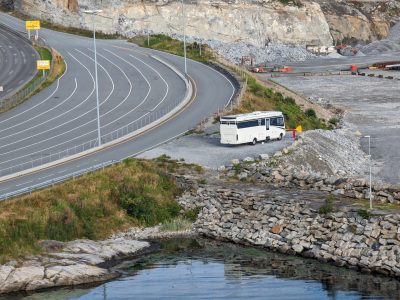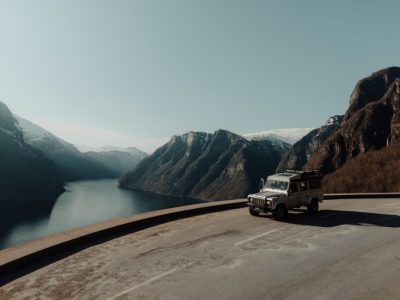Motorhome Holiday in Norway
Motorhome Travel Norway
National Tourist Routes in Norway. There are eighteen highways designated by the Norwegian Public Roads Administration for their picturesque scenery and tourist-friendly infrastructure, such as rest stops and viewpoints. The routes cover 1,850 kilometers (1,150 mi) and are located along the West Coast, in Northern Norway and in the mountains of Southern Norway. The authorities have coordinated the establishment of accommodation, cultural activities, dining, sale of local arts and crafts, and natural experiences along the tourist roads. The overall goal of the project is to increase tourism in the rural areas through which the roads run.

National Tourist Route Varanger runs along the Varangerfjord and the coast of the Barents Sea. From sheltered birch forests and marshlands across plains to rugged cliffs and a dramatic lunar landscape, this route offers a contrast-filled journey through scenery characterised by its Arctic climate. Varanger is one of the regions of Northern Europe which is richest in bird life and features in the book of «Top 100 Birding Sites of the World». Fisheries, migration and trade have turned Varanger into a melting pot of peoples and cultures.
National Tourist Route Havøysund takes you to the High North. The route follows the Arctic Ocean and meanders through a rugged landscape of cliffs and untamed nature where the bare mountains touch the oceans edge.
National Tourist Route Senja runs from Gryllefjord to Botnhamn on Norway’s second largest island. The drive along the outer edge of Senja island, along «the Devil´s Teeth», is a journey through a constantly changing landscape. Deep fjords, glistening beaches, precipitous mountainsides and vital fishing hamlets define the local scenery.
National Tourist Route Andøya runs along the outer edge of Andøya island, and offers a magnificent view of white sandy beaches, cragged peaks and the wide expanse of the ocean. The drive over Andøya island is characterised by an impression of wide marshes, with mountain peaks rising abruptly to 700 metres above sea level.
National Tourist Route Lofoten takes you on a drive through magnificent scenery and a vibrant coastal culture. The landscape is filled with contrasts ranging from the dramatic expanse of the ocean to craggy alpine peaks, glistening white sandy beaches, fishing hamlets in sheltered ports and verdant agricultural communities.
National Tourist Route Helgelandskysten is connected by six ferries, and offers a contrast-filled motoring experience through a verdant cultural landscape, peaks, glaciers, coasts and ocean currents. Various natural phenomena are found along the route. In the south you pass the Torghatten mountain with is characteristic hole and the peaks of The Seven Sisters, and in the north you can see the Svartisen glacier and the world’s strongest tidal current, the Saltstraumen.
Atlanterhavsvegen is a good example of how people and nature can interact successfully. The seven bridges that arch between the islets and skerries on the edge of the ocean not only present a magnificent view, they are also an outstanding feat of engineering.
Geiranger – Trollstigen An exceptional driving experience along a route steeped in tradition, through spectacular scenery of deep fjords and lush valleys – wild, wonderful and vibrant. The historic Trollstigen road, with its 11 hairpin bends, was opened in 1936, and in 2005 the Geirangerfjord was included on UNESCO’s World Heritage List.
The Rondane mountains exude a majestic serenity as if assured of their own grandeur and stability. The area can be explored in both summer and winter. The route follows the east side of Rondane National Park, passing through scenery that alternates between the cultural landscape on one side of the road and the mountain massif on the other.
Gamle Strynefjellsvegen The road between the east and west of Norway, which dates back over 100 years, is an experience in its own right. Old stone walls meticulously crafted by hand and long rows of guard stones define the character of the road leading across the mountain plateau. In the olden days, many routes through the mountains were used for transport on foot and on horseback, but the journey was invariably strenuous and demanding.
Sognefjellet On this journey along a route that for centuries has connected Norway’s east and west, you travel through Northern Europe’s highest mountain pass, at 1 434 metres above sea level. The Sognefjell road starts in the lush cultural landscape of Bøverdalen valley in the east and runs across the mountain plateau with panoramic views of glaciers and towering mountains before descending through valleys to the inner reaches of the Sognefjord with their tranquil hamlets in the west.
Gaularfjellet A serene journey passing protected rivers, waterfalls and a tranquil fjord. The road runs along an arm of the world’s longest fjord, the Sognefjord, before curving up the steep slopes to the mountain. Further on, the road follows the protected Gaula river system, which is famous for its many waterfalls, but also has white-water rapids and tranquil mountain lakes.
The road across the Valdresflye plateau provides expansive views of mountains and plains, from which it seems to swoop into the Jotunheimen massif like the beginning of an endless journey. To the north, you can catch a view of the Jotunheimen National Park, where the mountains are steeper and wilder than to the south, where the landscape widens into serene, rolling hills.
Aurlandsfjellet The route runs from fjord to fjord across high mountains where snow remains most of the summer. The viewing platform at Stegastein is a natural place to make a stop and offers a dizzying view over the fjord landscape. The Nærøyfjord, included on the World Heritage List, offers breathtaking scenery.
National Tourist Route Hardanger vidda across the largest mountain plateau in Northern Europe offers a contrast-filled journey from wide expanses and towering peaks, through deep and verdant valleys to turquoise fjords. The Hardangervidda plateau is Norway’s largest national park and a key habitat for Europe’s largest stock of wild reindeer. Experience the spectacular Måbødalen valley with its rare and precious plant life.
National Tourist Route Hardanger passes through a scenic area steeped in culture and tradition, where for more than a century travellers have come to experience mountains, fjords, waterfalls and glaciers. Hardanger has been a fruit-growing region since the 14th century. The soil along the fjords imparts a characteristically fresh and tangy flavour to the fruit, and in the growing season fruit is on sale from small stalls along the road.
Ryfylke This route passes through constantly changing scenery of verdant fjords and stark mountains. The drive through the Ryfylke region is a varied one, and the motorist encounters small hamlets and towns with active agriculture and a multitude of industries.
Jæren This is a journey through an open cultural landscape along the edge of the North Sea. Here, the sky is high, the horizon is wide and the sea is endless. The route passes through well-tended agricultural land. The dry stone walls are part of the cultural heritage, but have kept their function.
Kilde: nasjonaleturistveger.no






